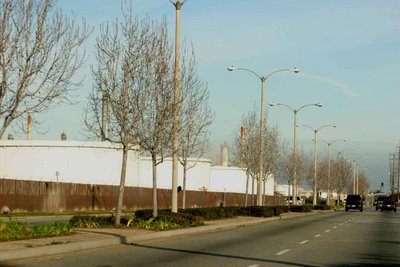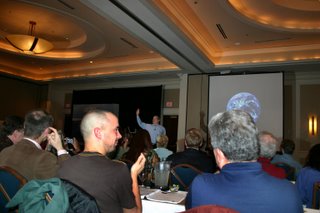
I have been pining for the mountains. I have been to busy to visit. The bug study, for me, is over but there are a few this and thats to do. I had to see what the few rains had done - if anything - to encourage weedy grasses and such.
As I drove up Highway 38 I noticed that the face of the hillside where the new community was built a few years ago in the mouth of the San Gabriel River as it leaves the foothills, was particularly dry looking. The soils around the vegetation was obviously exposed and light colored (dry), but the brush was brown. I stopped to shoot this image just as the local police were coming down the hill. The highway to the top veers to the right.

As I drove up the mountain, the slant of the faces were brown - I did not see much green from the Laural Sumac which dots the landscape. All around me, the valley looked dead.

The lower part of the San Gabriel Dam had water, but above, there were only tiny streams.

A section of the running water had red algae and the deeper section had green. The Forest Service and County people suspended a red tape so that the Off Road Vehicles would not run through our drinking water.

I just could not get over how bad the valley looked. How much of the vegetation was dead and how deep did the plants die? If we don't get more rain this could be the worst fire season ever. And, even if we do get enough rain to bring these plants back from the brink, there is something else needs addressing. Slides.

Roads into forests bring people with their weedy non-native grasses and other invasive plants, hitchhiking on shoes, tires, clothes, dogs, and hair. Roads also bite into the basic fragile structure of mountains and hillsides. It is normal for areas around roads to look different then areas without roads. This spot shows that the construction of the road plus the erosion and weeds, have created a situation where the integrity of the slope is becoming weak and, in a sense, is becoming fluid. This section of the slope near the road even looks like it is pouring and ready to slump onto the road below.

This area is were a hill slide occurred last year and the year before. There is nothing to prevent further erosion. Plants that could prevent further slumping do not have the time to grow and set roots. This area will continue to degrade until the flat stabilizes as a deep furrow... However, that may undermine the road and other hill side structures.

And... there is something else going on here.... The rains that did come may have caused more slumping and slides. The weather has been so dry for so long that plant roots are shallow. The dirt below the plants are bone dry and very friable. When the rains come, the soils at the surface become wet and heavier then the soil below, and the loose dry dirt act as ball-bearings carrying the plants and the hillside with them.

This slide is brand new. It was not there this last summer. You can see the dead sumac rinding down the slope on their shallow rooted toboggans.

Just as I turned around to go back, I noticed that there was the beginning of a new slide. The dust was rising and little cones of piled dirt had just formed. Sometime, soon this section will have a great bite out of the face of the mountain.

The mountains look sick. The vegetation seems not to be doing well. We need to do better.









